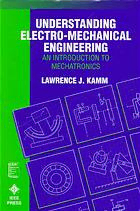Table Of ContentUnderstanding
Electro-Mechanical
Engineering
IEEE PRESS UnderstandingScience & Technology Series
The IEEEPRESSUnderstandingScience& TechnologySeriestreats
important topics in science and technology in a simple and easy-to
understand manner. Designed expressly for the nonspecialist engineer,
scientist, or technician as well as the technologically curious-each
volume stresses practical information over mathematical theorems and
complicatedderivations.
Books in the Series
Deutsch, S., Understanding theNervous System:AnEngineering
Perspective
Evans, B., UnderstandingDigital TV:The Route toHDTV
Hecht,J., Sr., UnderstandingLasers:AnEntry-Level Guide, Second
Edition
Kamm, L., UnderstandingElectro-MechanicalEngineering:An
Introduction toMechatronics
Kartalopoulos, S.V.,UnderstandingNeural Networks andFuzzy Logic:
Basic ConceptsandApplications
Nellist, J. G., Understanding Telecommunications andLightwave
Systems:AnEntry-Level Guide, Second Edition
Sigfried, S., Understanding Object-OrientedSoftware Engineering
Ideas forfuture topics and authorship inquiries are welcome.Please
write to IEEE PRESS: The UnderstandingSeries
Understanding
Electro-Mechanical
Engineering
An Introduction
to Mechatronics
J.
Lawrence Kamm
formerly President ofMOBOT Corp.
+
PRIEEESES
•
W
The Institute ofElectrical and Electronics Engineers, Inc., New York
IEEEPRESS
445HoeaLane,P.O.Box1331
Piscataway,NJ088li5·1331
EditorialBoard
J.B.Anderson,EditorinChief
S.Blanchard R.F.Hoyt R.S.Muller
R.S.Blicq S.V.Kartalopoulos I.Peden
M.Eden P.Laplante W.D.Reeve
R.Herrick J.M.F.Moura E.S4nchez-Sinencio
G.F.Hoffnagle
DudleyR.Kay,DirectorofBookPublishing
CarrieBriggs,AdministrativeAssistant
LisaS.Mizrahi,ReviewandPublicityCoordinator
TechnicalReviewen
AliSeireg
EbaughChairProfessor, UniversityofFlorida, Gainesville
KaiserChairProfessor, UniversityofWisconsin, Madison
DennisLieu
ProfessorofMechanicalEngineering,UniversityofCalifornia,Berkeley
Tzyh-JongTarn
Professor,SystemsScienceandMathematics,WashingtonUniversity
CharlesMischke,Ph.D.
EmeritusProfessorofMechanicalEngineering,IowaStateUniversity
SeymourKremen,Ph.D.
Consultant
Thisbookmaybepurchasedatadiscountfromthepublisherwhen
orderedinbulkquantities.Formoreinformation,contact:
IEEEPRESSMarketing
Attn:SpecialSales
P.O.Box1331
445HoesLane
Piscataway,NJ08855-1331
Fax: (732) 981-9334
@1996bythe InstituteofElectrical andElectronicsEngineers,Inc.
3ParkAvenue,17thFloor,NewYork,NY10016-5997
Allrightsreserved.Nopartofthisbookmaybereproducedinanyform,
normayitbestoredinaretrievalsystemortransmittedinanyform,
withoutwrittenpermissionfrom thepublisher.
10 9 8 7 6 5 4 3 2
ISBN0·7803·1031·4
IEEEOrderNumber: PP3806
LibraryofCongre&8Catalogin,.in.PublicationData
Kamm,LawrenceJ.
Understandingelectro-mechanicalengineering:anintroductionto
mechatronics/byLawrenceJ.Kamm
p. em.
Includesbibliographicalreferencesandindex.
ISBN0-7803-1031-4
1. Mechatronics. 2. Electromechanicaldevices. I. Title.
TJI63.12.K35 1995
621-dc20 95-16524
CIP
To Edith. Dorie. Ron. Megan. and Jeffrey
Brief Contents
List ofIllustrations xxv
Preface xxix
About the Author xxxi
Introduction 1
PART I Understanding the Science
and Technology 7
Chapter I ElectricalEngineering 9
Chapter2 Mechanical Engineering 35
PART II Understanding the Devices
and Systems 65
Chapter3 Generators and Motors 67
Chapter4 Brakes and Clutches 88
Chapter5 Amplifiers 101
Chapter6 Actuators III
Chapter7 Transducers 128
Chapter8 ControlledMotion 153
Chapter9 Contact Makers and Electrodes 172
vii
viii BriefContents
Chapter 10 ComputerComponents 202
Chapter 11 MarkingPaper 212
Chapter 12 Sound 222
Chapter 13 Manufacturing 229
Chapter 14 Assemblingand Connecting 239
Chapter 15 MilitaryDevices 254
Chapter 16 MedicalDevices 257
Chapter 17 ConsumerDevices 263
Chapter 18 Passive Electrical Components 268
PART III Understanding Design 273
Chapter 19 The Science and the Art 275
Chapter20 How One Designs 278
Chapter21 Minimum ConstraintDesign 284
Chapter22 Designfor Manufacturing 289
Chapter23 User-FriendlyDesign 294
Chapter24 Accuracy. Adjustment. and Gauging 297
Chapter25 Reliability.Defects, Abuse, Failure. and
Maintenance 300
Chapter26 Barriers,Filters, Conduits, and Valves 309
Chapter27 Ecology 320
Chapter28 Money 324
Chapter29 Cost Reductionand Product Improvement 327
Chapter30 Constraints on Design 334
Chapter31 People Engineering 337
Chapter32 GettingHelp 345
Chapter33 DesignParameters 349
Chapter34 Product Classes and Families 352
Appendix Patent Classification 357
References and Bibliography 361
Index 371
Contents
List ofIllustrations xxv
Preface xxix
About the Author xxxi
Introduction 1
PART I Understanding the Science
and Technology 7
Chapter 1 Electrical Engineering 9
1.1 ElectricalConduction 9
1.1.1 Solids 9
1.1.2 Liquids 10
1.1.3 Gases 11
1.1.4 Contacts 11
1.2 ElectricalInsulation 13
1.2.1 Solids 13
1.2.2 Liquids 14
1.2.3 Gases 14
1.3 Electro-Magnetism 14
1.3.1 Magnetism 14
1.3.2 FluxLinkage 16
1.3.3 InducedVoltage 18
1.3.4 Electro-MagneticForce 19
1.3.5 PermanentMagnets 20
x Contents
1.3.6 ElectricPower 21
1.4 Electro-MagneticRadiation 21
1.4.1 GammaRays 22
1.4.2 X-Rays 22
1.4.3 Visible Light 22
1.4.4 InfraredRays 23
1.4.5 Microwaves 23
1.4.6 Radio Waves 23
1.5 NuclearRadiation 24
1.6 Piezoelectricand MagnetorestrictiveEffects 24
1.7 Electro-StaticEffects 25
1.8 Electro-ExplosiveEffects 25
1.9 Electro-ThermalEffects 26
1.10 Electro-ChemicalEffects 26
1.11 Electro-BiologicalEffects 27
1.12 Electrical-MechanicalAnalogs and Analog
Computing 28
1.13 Digital Computers 31
1.14 Communications 32
1.15 Solid-StateDevices 34
1.16 Circuits, Fields, and Non-Linearity 34
Chapter2 Mechanical Engineering 35
2.1 Sound 35
2.2 Mechanical PropertiesofMaterials 36
2.3 Beams 37
2.4 Statics 39
2.5 Dynamics 39
2.5.1 Newton's Laws 39
2.5.2 Gyroscopes 40
2.6 Kinematics 43
2.6.1 Moving Bodies 43
2.6.2 Backlash 43
2.6.3 Preload 43
2.6.4 Hysteresis 44
2.6.5 CoordinateSystems 44
2.7 Friction 45
2.7.1 StartingandSliding 45
2.7.2 VibrationandFriction 46
2.7.3 VacuumandFriction 47
2.7.4 Tribology 47
2.8 Bearings 47
2.8.1 PlainJournalBearings 47
2.8.2 HydrodynamicBearings 48
Contents xi
2.8.3 HydrostaticBearings 49
2.8.4 Rolling Bearings 49
2.8.5 Conical Pivots 50
2.8.6 Knife Edge and FlexureBearings 50
2.8.7 LinearBearings 51
2.8.8 Ball Screws 52
2.8.9 Rolls 54
2.8.10 Buoyancy 54
2.9 Heat 55
2.10 Fluid Power 55
2.11 Mechanical Fabrication 55
2.11.1 ManufacturingSolid StateDevices 56
2.11.2 Lithography 56
2.12 Flexible Devices 58
2.12.1 Silicon Devices 58
2.12.2 QuartzDevices 58
2.12.3 OtherDevices 58
2.13 CommercialMechanical Components 59
2.14 Null Measurement 59
2.15 Oscillation 60
2.15.1 General 60
2.15.2 FeedbackControl 61
2.16 Mechanism 62
PART II Understanding the Devices
and Systems 65
Chapter3 Generators and Motors 67
3.1 General 67
3.1.1 Speed 70
3.2 DCGenerators 71
3.3 ACGenerators 72
3.4 Magnetos 73
3.5 Alexanderson Generators 73
3.6 Motors 73
3.7 Electronic PowerSupplies 75
3.8 Single-Phase Motors 76
3.9 Speed Control 77
3.10 StartingLarge Motors 77
3.11 SteppingMotors 78
3.12 Series Motors 78
3.13 Braking 78

